Outsourcing to Czechia

How much does it cost to hire developers in Czechia?
Dec 2nd 25 - by Devico Team
Find out how much it costs to hire software developers in Czechia in 2025. Compare hourly rates, roles, and factors that impact pricing.
Hire
Hire by role
Hire Front-end developers
Hire Back-end developers
Hire Full-stack developers
Hire Android developers
Hire iOS developers
Hire Mobile developers
Hire AI engineers
Hire ML engineers
Hire Automation QA engineers
Hire Blockchain developers
Hire Data engineers
Hire Cloud engineers
Hire by skill
Hire JavaScript developers
Hire TypeScript developers
Hire Ruby on Rails developers
Hire React Native developers
Hire Flutter developers
Hire Golang developers
Hire React.js developers
Hire Python developers
Hire PHP developers
Hire .NET developers
Hire Java developers
Hire Laravel developers

BOT
August 09, 2024 - by Devico Team
Summarize with:
IT spending is going to hit USD 5T in 2024, according to Gartner. And the most interesting insight is that the lion’s share of these expenditures falls down to outsourcing IT strategy.
There is nothing groundbreaking here, considering that outsourcing has significant financial implications. A Deloitte survey found that 76% of companies use outsourcing to reduce costs, and 52% focus on core business functions.
The BOT model enhances these benefits by ensuring a structured transition and reducing risks associated with sudden operational shifts.
Spelling out, it is a strategic approach to IT outsourcing where an external partner builds the infrastructure, operates it and eventually transfers control to the client. This model helps organizations leverage external expertise while gradually integrating operations in-house.
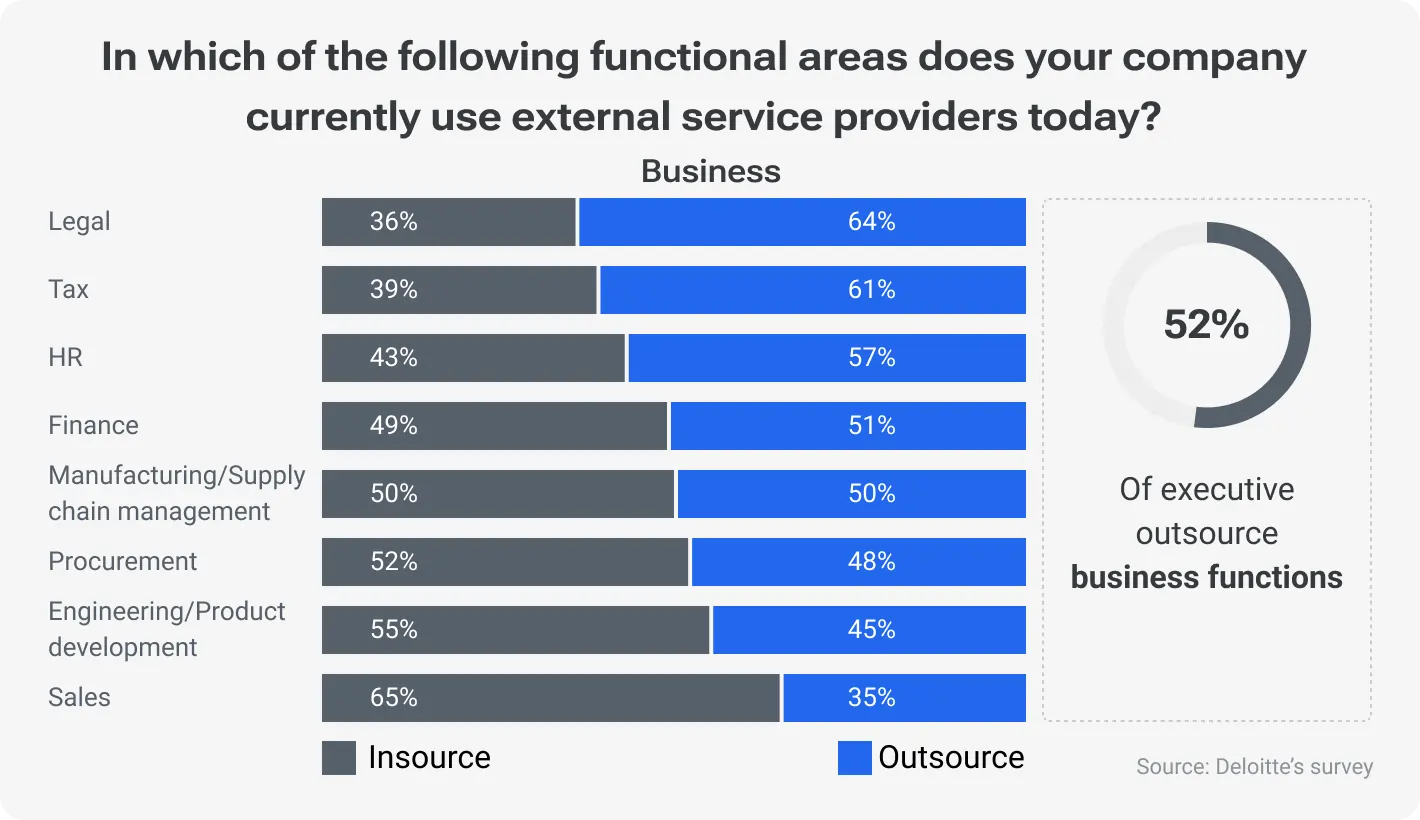
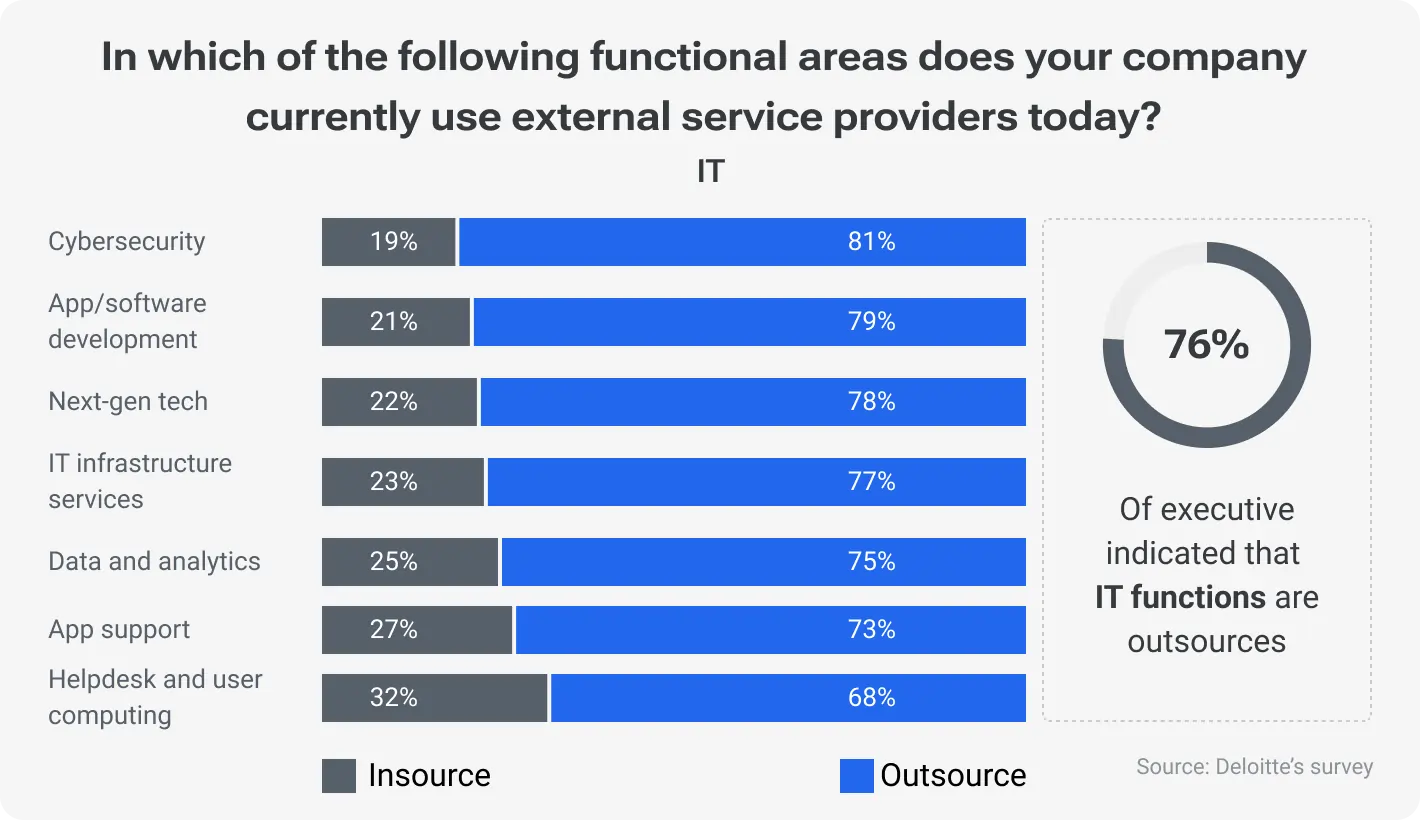
Further down we will provide a step-by-step guide on transforming your IT team and processes using the BOT model. We will explore how to implement each phase effectively and highlight the immediate and long-term value it delivers.
IT department transformation with the BOT model is akin to a well-choreographed dance: an experienced partner guides your company through a series of carefully orchestrated steps to implement tech changes you want.
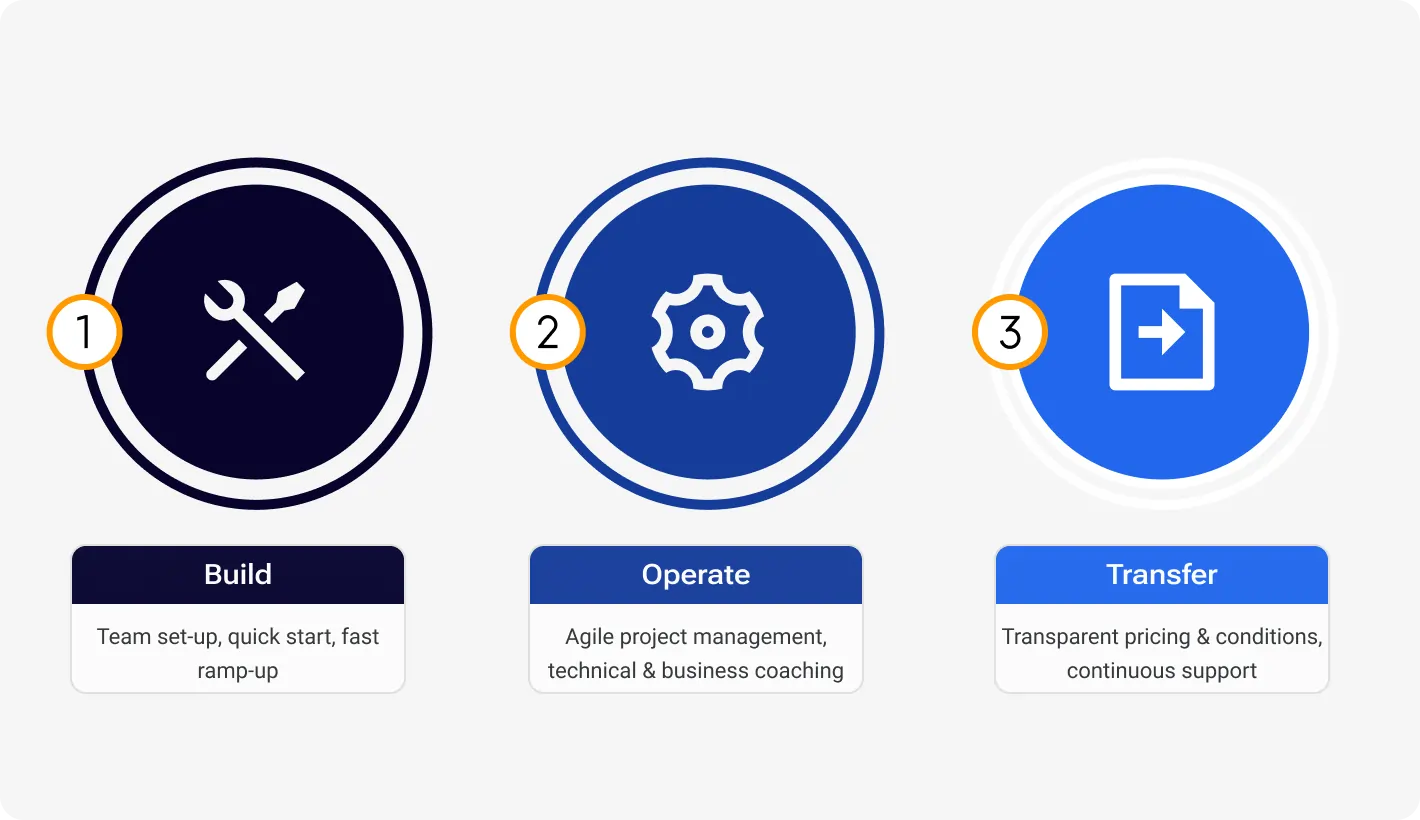
Let’s flip over this metaphor in a more straightforward way — the BOT approach involves three distinct phases:
Build: The external partner sets up the necessary IT infrastructure, recruits the required talent, and develops foundational systems and processes. It’s like preparing a complex machine: assembling parts, ensuring each component works, and calibrating it for optimal performance.
Operate: Here, the external partner takes over the day-to-day operations. They ensure systems run smoothly, optimize performance, and address any issues. Think of it as the machine running under the supervision of experts who fine-tune it for peak efficiency.
Transfer: Finally, ownership and control are gradually handed over to the client. This phase is like training the client’s team to operate the machine independently, ensuring they understand every part and can maintain its performance.
Cost efficiency in IT: Leveraging the external partner’s infrastructure and resources minimizes initial costs. This spreads out capital expenditures and provides predictable long-term costs, crucial for budget-constrained IT departments.
Risk mitigation: The client lowers the risk since the responsibility is shared in the build and operate phases. On the one hand, this is a good way to stay focused and alert. On the other, you have an additional state that demands your attention. Yet, if your partner has domain expertise, it’ll help navigate potential issues and ensure a smooth transition.
Narrow experts and top generalists at your fingertips: Note to startup founders: Poland has over 500K ICT specialists with 40% open to outsourcing though. While Ukraine with its 300K ICT pros still remains a top European outsourcing destination irrespective of the war. Extended expertise avoids the lengthy and costly process of building an internal team from scratch.
Long-term control: Consistent step-by-step transfer ensures the client gains full control over operations, which aligns with strategic goals and maintains continuity.
Build-Operate-Transfer is particularly suitable for transforming IT departments because of its structured approach and comprehensive support.
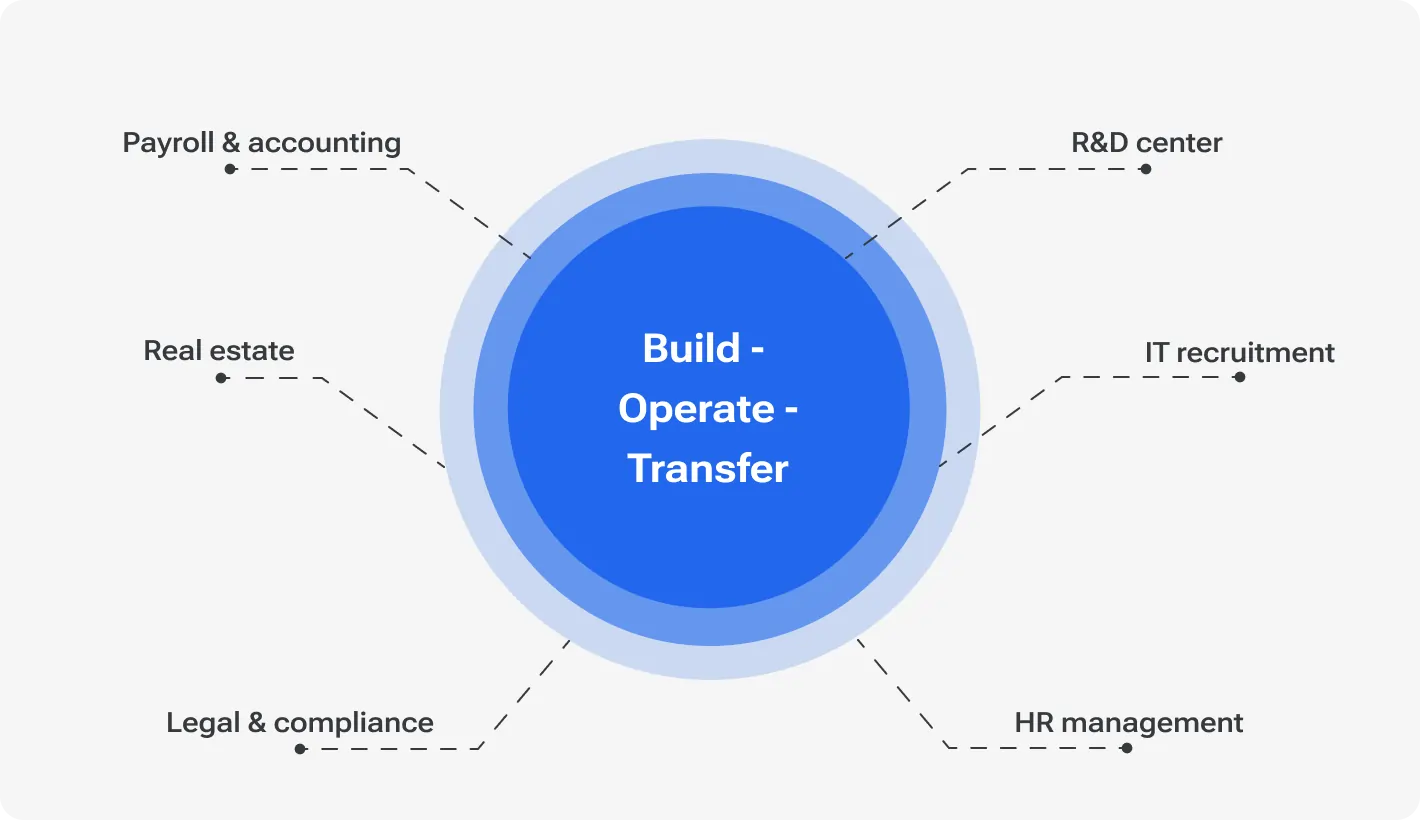
Cost constraints: Every IT implementation guide must warn you of potential exceeding initial budgets. That’s why startups should consider BOT — they could do with predictable costs and efficient resource allocation.
Skill gaps: Access to a skilled workforce helps IT departments overcome talent shortages. Emerging Europe report estimates 4,500 and 6,500 software development vendors with over 1.4M software developers on side.
Scalability: The BOT model supports scalable growth, allowing IT departments to expand operations smoothly as business needs evolve.
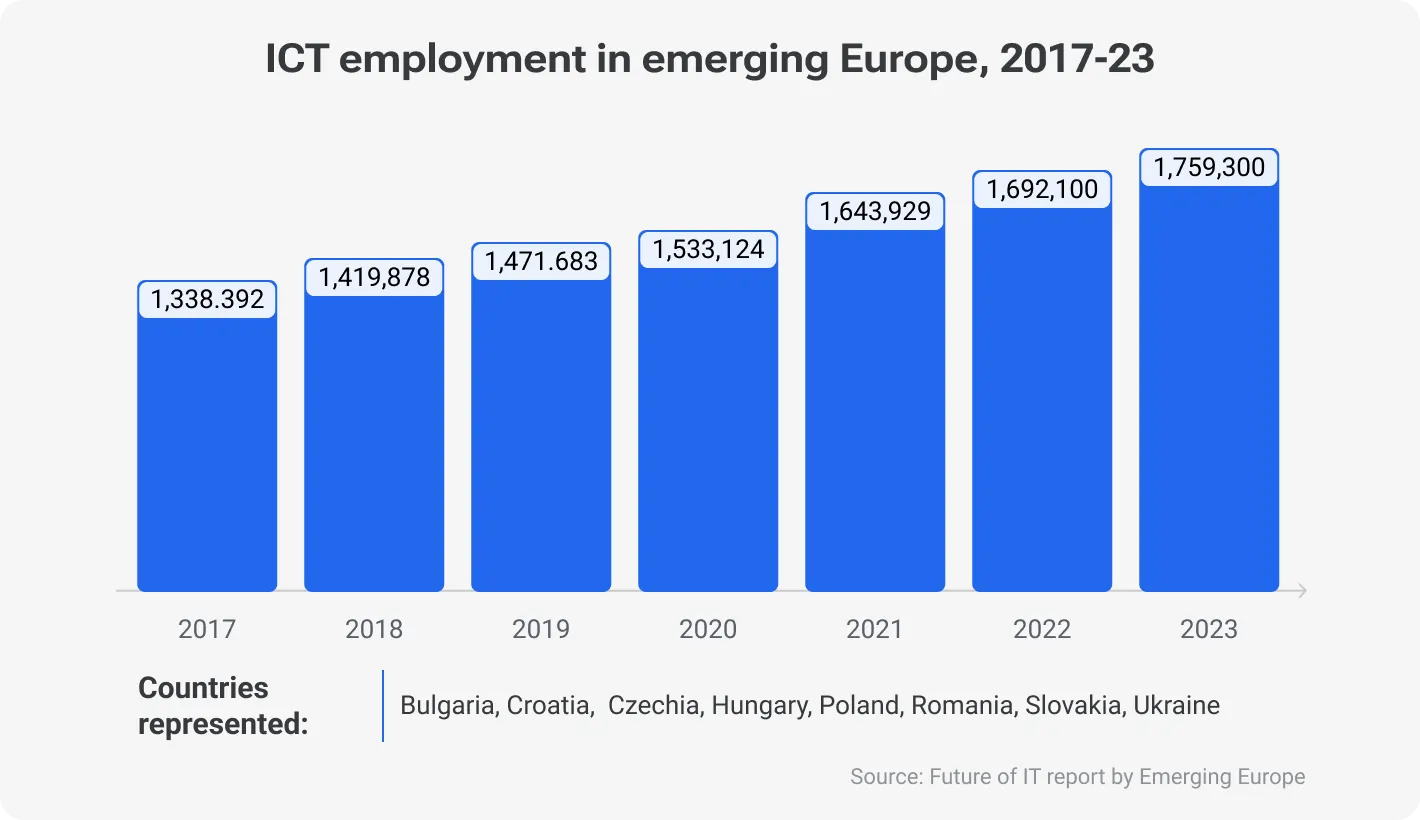
Initial Setup: When setting up IT infrastructure, the #1 choice (that is a must-have now) is cloud-based solutions like AWS or Azure. They offer scalable and cost-effective services. This reduces the need for significant capital investment in physical servers and data centers.
Recruitment: According to SHRM, the average time to hire a software engineer in the US is about 42 days, with an average cost of USD 4,700 per hire. The BOT model can speed up this process by leveraging the partner’s existing recruitment channels and expertise.
Continuous Monitoring: During the operate phase, using tools like Nagios for system monitoring and Jira for project management ensures ongoing optimization and quick issue resolution.
The BOT model can empower your business model through meticulous transformation, enhancing your capabilities and aligning more closely with your strategic objectives.
Probably the most obvious advice yet the most important since all instruments will depend on that and, hence, the result. Take these actions:
Dive into existing systems: Examine the current IT infrastructure, software, and processes to identify areas that need improvement or replacement. The most popular and applicable to start is a SWOT analysis (Strengths, Weaknesses, Opportunities, Threats).
Identify key areas for improvement: Focus on aspects like system performance, scalability, security, and user satisfaction. For instance, a startup might identify slow system response times and frequent downtimes as key areas for improvement.
Engage stakeholders early: Include input from various departments to ensure all critical needs are addressed. Conduct surveys or meetings with key personnel — step #1.
Setting clear objectives and aligning them with business goals is essential. Objectives should be specific, measurable, achievable, relevant, and time-bound (SMART). Typical IT objectives:
Enhancing system performance: Reducing system downtimes and improving response times.
Scalability: Ensuring the IT infrastructure can handle increasing loads as the business grows.
Security improvements: Enhancing data security measures to protect against breaches.
A proven track record in your niche is the biggest green flag when choosing an outsourcing partner. What else?
Cultural fit: Ensure the partner’s work culture aligns with your company’s values and practices. For example, McKinsey has an internal rule when validating ideas: listeners must disagree with the presenter and offer alternatives. Interesting practice many companies won’t be prepared for. So, alignment enhances collaboration and reduces conflicts.
References and case studies: Evaluate potential partners by reviewing their past projects. Ask for references and examine case studies to understand their capabilities and track record.
Interview process: Run interviews with the potential partners to gauge their understanding of your needs and their proposed approach. It’d be better to focus on the soft skills of the partner’s team since they show openness and willingness to dive deeper into your goals and needs which sometimes makes a difference throughout the project.
The BOT model's success is ground on trust and two-way understanding. Communicate sincerely, trust your partner, and align objectives to hit your jackpot.
Infrastructure and technology stack selection: Collaborate with your outsourcing partner to determine the optimal infrastructure setup for your needs. Chances are you need to migrate workloads to the cloud, leverage Infrastructure-as-Code (IaC) tools for automation, and utilize containerization technologies like Docker for efficient resource utilization. Additionally, select the technology stack that aligns with your project requirements:
Cloud platforms (e.g., AWS, Azure, GCP) for scalability and elasticity.
DevOps tools (e.g., GitLab, Jenkins) to streamline development, deployment, and operations.
Monitoring and logging solutions (e.g., Prometheus, ELK Stack) for real-time visibility and troubleshooting.
Security solutions (e.g., firewalls, intrusion detection systems) to ensure data protection and regulatory compliance.
Talent acquisition: The partner recruits skilled professionals to build the project team. We’ve already mentioned the average cost to hire a software engineer in the US; it is USD 4,700, and it can take approximately 42 days to fill a position.
Realistic timeline: Develop a comprehensive project timeline that outlines key milestones, deliverables, and dependencies. Take into account resource availability, technology integration timeframes, and potential risk mitigation strategies.
Planning the build phase requires careful consideration of timelines and resource allocation since it’s the groundwork for your project's takeoff. Depending on the project's complexity, this phase can typically last from a few weeks to several months.
The operate phase is where the external partner manages the day-to-day IT operations. Here are some key activities:
Managing IT operations: The partner takes over all routine tasks, ensuring the high availability and performance of IT systems.
Server and application management: System uptime, performance optimization, and timely patching of vulnerabilities.
End-user support: Providing technical assistance to internal users for any IT-related issues.
Security monitoring: Continuously monitoring for security threats and implementing necessary mitigation measures.
Optimizing processes: Continuous process improvement is key to operational control. Like refining workflows, automating repetitive tasks, and implementing best practices in IT strategy.
Monitoring performance: Here, the outsourcing partner may use something like Nagios, New Relic, or Datadog to track system performance, identify bottlenecks, and address issues proactively.
The outsourcing partner's role is vital in this phase (where is it not vital?🙂). With its expertise and special tools it ensures operational efficiency to meet performance metrics and eventually beat the project’s to-do list.
Regularly reviewing performance data and feedback allows for iterative enhancements, ensuring IT operations remain aligned with business goals.
Obviously, the operate phase also has its challenges like maintaining service levels and managing operational risks. How can you overcome them? You have at least two options:
Service level agreements (SLAs): Define clear SLAs with performance benchmarks to ensure accountability.
Risk management plans: Develop comprehensive risk management plans to address potential operational risks. This includes regular security audits and disaster recovery plans.
The transfer phase is when the partner gradually hands over control and ownership of IT operations to the client. Key aspects:
Knowledge transfer: Effective knowledge transfer is critical. This involves comprehensive training sessions and detailed documentation handover. The top nuances to focus on are:
Detailed documentation: Ensure all processes, workflows, and systems are thoroughly documented.
Hands-on training: Conduct hands-on training sessions to facilitate practical learning.
Continuous support: Provide a support period where the partner remains available for queries and troubleshooting.
Gradual transition: The transition of ownership and control should be gradual to ensure a smooth handover. This phased approach reduces the risk of operational disruptions and ensures the internal team is fully prepared.
Benefits of full control: Having full control over IT operations post-transfer allows the startup to tailor processes to their needs, improve response times, and foster innovation. It also ensures better alignment with long-term business goals.
So, what are the common challenges during the transfer phase? Usually, it’s knowledge gaps and resistance to change. And your solutions are:
Regular knowledge audits: Conduct audits to identify and fill knowledge gaps.
Engagement strategies: Involve employees early in the transition process and provide incentives for their participation.
Change management programs: Develop change management programs with clear communication, training, and support systems.
To top that, let’s list your raiders for managing resistance to change.
Clear communication: Clearly explain the benefits and reasons for the change.
Involvement and empowerment: Involve employees in the transition process and empower them to contribute ideas and feedback.
Leaders’ example: Ensure your board and leadership are the first employees to show how-to.
Support systems: You could do with the ongoing support and resources to help employees adapt to new processes and systems.
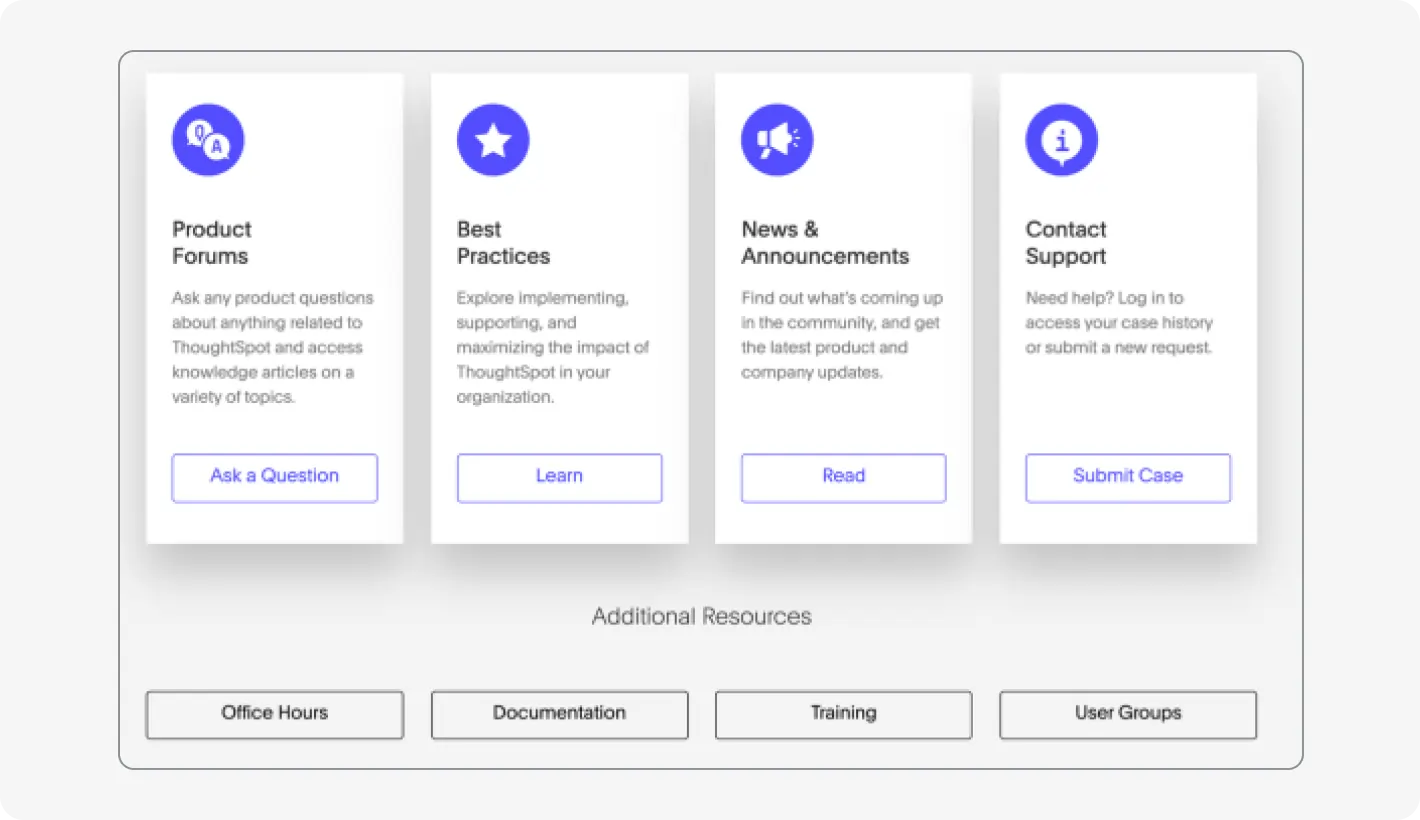
ThoughtSpot, an analytics platform, successfully built an internal knowledge base with the help of an external partner.
They documented all critical processes and provided comprehensive training to their internal team. With detailed documentation, hands-on training, and continuous support, ThoughtSpot smoothly transitioned control of its IT operations to its internal team.
This approach saved them time, money and human resources in a way to their business objectives.
The Build-Operate-Transfer model is designed to deliver value to almost any company from the moment they begin their IT department transformation. It delivers tangible benefits throughout the entire lifecycle, from the very beginning and well into the future.
This model delivers value through rapid deployment, enhanced operational efficiency, and cost savings. With an external partner's expertise and their infrastructure, startups can quickly set up their IT operations and grab the market’s share much faster.
This rapid deployment (which is often 50%-60% faster than traditional methods) allows businesses to start operating efficiently from day one. For instance, using cloud services like AWS can significantly reduce infrastructure setup time.
Another point: 96% of surveyed executives state that they leverage service provider’s analytics capabilities. This data simply helps companies to understand their pace, quality of development, and return of their efforts.
With skilled professionals and advanced tools, the BOT model ensures high system performance and reliability. Deloitte's 2022 outsourcing report revealed: companies that outsource IT operations can achieve up to 40% reduction in downtime and a 30% increase in operational efficiency.
Rapid deployment of new systems: Apart from other software, a startup can quickly implement a customer relationship management (CRM) system using the partner’s resources, and this way, enhance customer management from the start.
Improved operational efficiency: Immediate access to a team of experts streamlines processes and improves service delivery.
Cost savings: While cost savings have a cumulative effect, they also may come across as a fast win as well. Who doesn’t like financial relief?
The BOT model provides sustained operational control, strategic alignment, and scalability in the long run. Once the operations are transferred to the client, they gain full control over the IT infrastructure and hence achieve better alignment with business strategies. This control ensures that the IT operations support their long-term goals.
As we stated, cost savings are another significant benefit. The BOT model spreads initial capital expenditures over time, allowing startups to manage their budgets more effectively. Additionally, outsourcing reduces the need for significant upfront investments in infrastructure and talent, leading to overall cost reductions.
What way?
Economies of scale: Outsourcing partners benefit from economies of scale, allowing them to offer services at a lower cost than internal IT teams can manage.
Reduced labor costs: Organizations can potentially reduce their internal IT staff size, leading to direct salary and overhead savings.
Improved resource allocation: By offloading non-core IT functions, internal teams can refocus their efforts on strategic IT initiatives that drive business value.
The gradual transfer process ensures that the client’s team is well-prepared to take over operations seamlessly.
Also, we can’t help but admit: talent acquisition remains the top challenge for top US executives. And the BOT model helps handle all related issues.
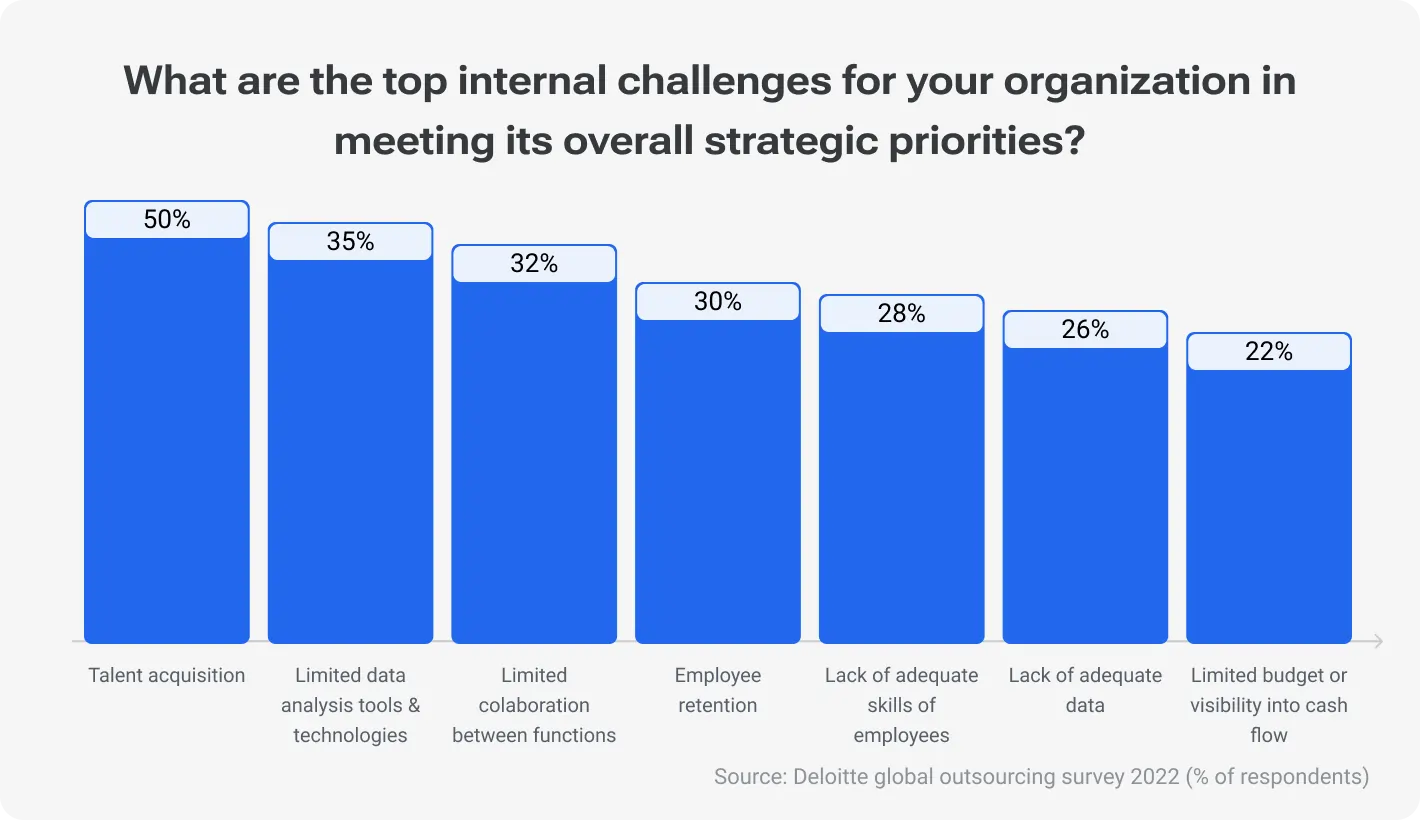
And scalability. It’s another long-term advantage. The BOT model supports the scalable growth of IT operations, enabling businesses to expand their capabilities as they grow. This way, the company ensures that the IT infrastructure can adapt to increasing demands (if any) without significant overhauls.
A VoIP and messaging app Viber used the BOT model to expand its development capabilities. Let’s take a look at their journey:
Build phase: Viber partnered with an IT outsourcing company to set up a new development center in Europe. The partner assembled teams for Android, Windows Phone, and desktop development. They dedicated office space and established a secure and flexible communication environment.
Operate phase: The development teams worked under Viber's management, using Scrum methodology to ensure efficient project progress. Daily communication and reporting maintained alignment with Viber's goals. The teams grew over a year, integrating web backend developers to enhance the development process.
Transfer phase: As Viber's user base grew to 800M, they decided to move the team to their own legal entity. Outsourcing partner assisted in onboarding the entire team, ensuring a smooth transition.
Key outcomes: Rakuten subsidiary company significantly expanded its market presence, enhanced operational control, and implemented rapid development cycles. The BOT model enabled the messaging giant to tap into high-quality talent and maintain continuous development, which boosted its market competitiveness.
Maintaining effective communication is paramount for a successful BOT implementation.
Choose communication channels wisely: Define designated points of contact within both your organization and the outsourcing partner. Use all relevant channels: in-person meetings, video conferencing, and project management tools (Jira, Asana, etc.). Some big clients require certain collaborative tools due to security concerns. For example, Deloitte works with Microsoft products, so they chat in MS Teams.
Update proactively: Maintain open communication throughout the project lifecycle. Regularly share project updates, potential roadblocks, and decision-making rationale with stakeholders. Encourage open dialogue since trust is what success is built on.
Articulate business objectives clearly: Clearly define your business objectives for the BOT model implementation. This will provide a shared vision for both teams and ensure the project aligns with your company’s overall goals.
Setting and managing expectations from the outset is essential. Clearly define the scope, timelines, and deliverables for each phase. This clarity helps prevent misunderstandings and scope creep. Using a detailed Statement of Work (SOW) document can outline these aspects, ensuring both parties have a mutual understanding of the project's objectives and metrics for success.
As we said, trust is key. Strong, collaborative partnership with the outsourcing provider always pays off. Treat the external team as an extension of your internal team: share culture ABCs, best practices and your experience. You can even set up some team-building activities.
Don’t shy away from involving the external team in strategic planning sessions — this also helps align their efforts with your business goals.
A comprehensive framework to ensure readiness and smooth execution includes:
Pre-implementation assessment: Conduct a thorough assessment of your current IT landscape and identify key areas for improvement. Define clear objectives and ensure they align with your business goals.
Detailed planning: Develop a detailed project plan that outlines each phase of the BOT model. This should include timelines, milestones, resource allocation, and risk management strategies.
Resource allocation: Ensure you have the necessary resources in place, including budget, personnel, and tools. This may involve hiring additional staff or investing in new technologies.
Knowledge transfer strategy: Develop a robust knowledge transfer strategy to ensure smooth handover from the external partner to your internal team. This should include detailed documentation, hands-on training sessions, and continuous support.
Continuous monitoring and improvement: Implement regular monitoring and feedback mechanisms to track progress and identify areas for improvement. This can involve regular performance reviews, feedback sessions, and process audits.
Practitioners on forums and dev communities suggest focusing on cultural alignment and understanding the partner’s work ethic. One tip from experienced managers is to start with a pilot project to test the collaboration before fully committing. This allows you to gauge the partner’s capabilities and working style.
Another insider tip is to leverage automation tools to streamline operations during the Operate phase. Tools like Ansible for automation, Nagios for monitoring, and Jenkins for CI/CD can significantly enhance efficiency and reduce manual workloads.
The step-by-step IT department transformation begins with acknowledging the need for changes. And this is where the Build-Operate-Transfer model comes into play.
To get immediate and long-term value from implementing this approach you should assess your IT needs, select the right outsourcing partner, and execute each phase of the model: Build, operate, and eventually, the transfer phase.
The BOT model can transform IT departments by enabling rapid deployment, enhancing operational efficiency, and achieving cost savings from day one. Anyway, long-term benefits like sustained operational control, strategic alignment, and scalability are definitely worth careful planning and thorough execution.
The transformative potential of such an approach makes it a compelling choice for IT departments seeking to optimize their operations and achieve strategic goals. Startups and established companies can benefit from the structured, phased implementation, which leverages external expertise while ensuring a seamless transfer of operations.
Visit our dedicated BOT page or contact us immediately to schedule a free consultation with our team.
Outsourcing to Czechia

Dec 2nd 25 - by Devico Team
Find out how much it costs to hire software developers in Czechia in 2025. Compare hourly rates, roles, and factors that impact pricing.
Outsourcing to Czechia

Nov 25th 25 - by Devico Team
Compare Czechia and Poland for software outsourcing in 2025. Discover costs, talent, infrastructure, and which country fits your project best.
Outsourcing to Czechia

Nov 18th 25 - by Devico Team
A complete guide to outsourcing software projects to Czechia, learn about costs, talent, benefits, and how to build successful partnerships in 2025.